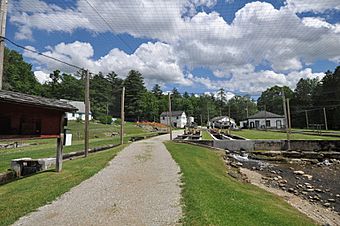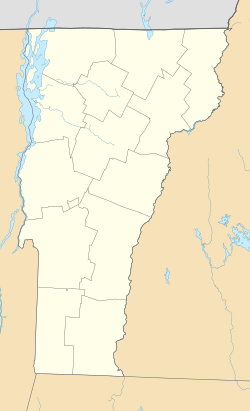Bennington Fish Hatchery facts for kids
Quick facts for kids |
|
|
Bennington Fish Hatchery
|
|
 |
|
| Location | South Stream Rd., Bennington, Vermont |
|---|---|
| Area | 118.5 acres (48.0 ha) |
| Built | 1916 |
| Built by | Lambert & Burrington |
| Architectural style | Colonial Revival |
| MPS | Fish Culture Resources of Vermont MPS |
| NRHP reference No. | 94000376 |
| Added to NRHP | April 21, 1994 |
The Bennington Fish Hatchery is a special place in Bennington, Vermont. It's also known as the Bennington Fish Culture Station. This hatchery is run by the state of Vermont. Its main job is to raise different kinds of trout fish. These fish are then released into Vermont's lakes and rivers. This helps keep the fish populations healthy for fishing! The hatchery started way back in 1916. It's so important that its buildings are listed on the National Register of Historic Places. You can even visit it, as it has a visitors' center open every day.
What is the Bennington Fish Hatchery Like?
The Bennington Fish Culture Station is located southeast of downtown Bennington. It sits next to South Stream Road, which runs along South Stream. This stream flows north into the Walloomsac River.
The hatchery covers more than 118 acres of land. It has buildings and fish ponds on both sides of the stream. Some of the buildings are very old. They were built when the hatchery first started in 1916.
For example, the original office and home for the superintendent (the person in charge) is still there. Today, this building is the visitors' center. The main hatchery building is also from 1917. It's a beautiful building built in the Colonial Revival style.
What Kinds of Fish Are Raised Here?
The Bennington Fish Hatchery raises several types of trout. These include brown trout, brook trout, and rainbow trout. Once the fish are big enough, they are moved to lakes and ponds all over Vermont. This helps make sure there are plenty of fish for anglers (people who like to fish).
How Did the Bennington Fish Hatchery Start?
The state of Vermont started this hatchery as an experiment in 1916. They had tried another experimental station in Arlington, Vermont, but it wasn't big enough. The Bennington location was chosen because it had a good, reliable water source.
After proving how well it worked, the hatchery became a permanent place. By the 1930s, it was a top example of a fish hatchery. It sent thousands of pounds of young fish, called fingerlings and fry, all across the state.
In the 1940s, the hatchery grew even more. It received money from the Works Progress Administration (WPA). The WPA was a government program that helped build things during the Great Depression. This funding helped expand the hatchery's facilities a lot.



